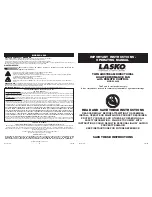
1-1
Chapter 1. Warnings, cautions, and notes
Before using the Respironics V60/V60 Plus Ventilator on a patient, familiarize
yourself with this user manual, particularly the safety considerations listed. Be
aware, however, that this manual is a reference only. It is not intended to
supersede your institution’s protocol regarding the safe use of assisted
ventilation.
Definitions
WARNING:
Alerts the user to the possibility of injury, death, or other serious adverse
reactions associated with the use or misuse of the device.
CAUTION:
Alerts the user to the possibility of a problem with the device
associated with its use or misuse, such as device malfunction, device
failure, damage to the device, or damage to other property.
NOTE:
Emphasizes information of particular importance.
General
WARNING:
Always have immediate access to an alternative means of ventilation. If
there is a ventilator failure, immediately remove the ventilator from use
and secure an alternative means of ventilation, such as a self-inflating,
manually powered resuscitator and mask. Failure to do so can result in
patient injury or death.
WARNING:
Use the Respironics V60/V60 Plus Ventilator on spontaneously breathing
patients only. It is an assist ventilator and is intended to augment the
ventilation of a spontaneously breathing patient. It is not intended to
provide the total ventilatory requirements of the patient.
WARNING:
We do not recommend you use the Respironics V60/V60 Plus Ventilator
on patients who require ventilation at predetermined tidal volumes. The
ventilator provides continuous positive airway pressure (CPAP) and
positive pressure ventilation (S/T, PCV, AVAPS, and PPV) and is indicated
for assisted ventilation only. These modes do not provide ventilation with
guaranteed tidal volume delivery.
Summary of Contents for Respironics V60
Page 1: ...Respironics V60 V60 Plus Ventilator User Manual ...
Page 2: ......
Page 8: ...viii ...
Page 28: ...2 10 Symbols ...
Page 44: ...3 16 General information ...
Page 60: ...4 16 Principles of operation ...
Page 74: ...5 14 Setting up the ventilator for use ...
Page 102: ...6 28 Operation ...
Page 110: ...7 8 High flow therapy ...
Page 114: ...8 4 Patient monitoring ...
Page 132: ...9 18 Alarms messages and troubleshooting ...
Page 142: ...10 10 Care and maintenance ...
Page 162: ...A 10 First time installation ...
Page 182: ...D 10 Regulatory compliance ...
Page 198: ...E 16 Diagnostic mode ...
Page 210: ...Index Index 6 ...
Page 211: ......










































